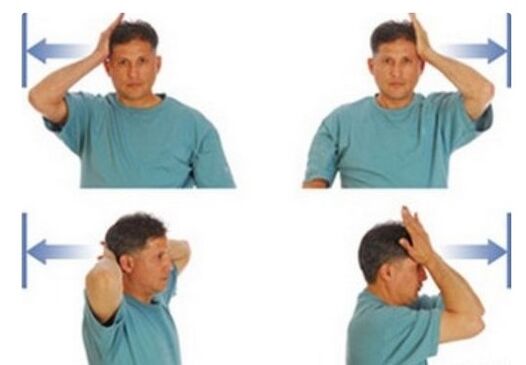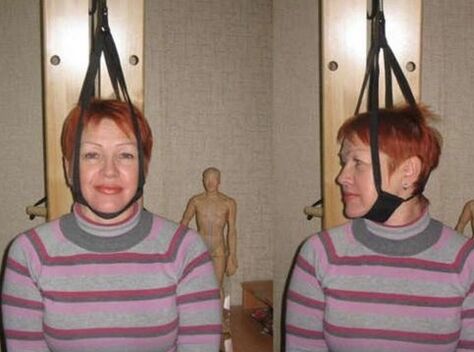Osteochondrosis of the cervical region is a dangerous disease and, if it is not treated, you can become a disabled person. Faced with this disorder, many people think about how to deal with it. Let's discover the complexities of the disease.

The osteochondrosis of the cervical column is a disease that has its symptoms, stages, causes and treatment.
The nature of the disease
The osteochondrosis of the cervical vertebra is a progressive disease, which is characterized by degenerative and dystrophic changes in the discs between the vertebrae.
The cervical department is represented by the seven vertebrae and is the most mobile, but the muscle corset is poorly developed. He is responsible for the slopes of the head on the sides and his curves.
Phases of the course of the disease
The development of the disease occurs in four phases and the degree stands out:
- 1 degree.The stadium is characterized by instability manifested in the initial destruction of the records.
- 2 degrees.At this stage, the protrusion of the records is manifested. The distance between the vertebrae is reduced, the destruction of the fiber ring begins, while the pain occurs due to the pinch of the nerve.
- 3 degrees.The ring is finally destroyed and the hernias are formed between the vertebrae. The spine is very deformed.
- 4 degrees.It is the most difficult. Each movement causes severe pain. With a strong increase in bone tissue, the disease leads to disability.
The image illustrates the phases of the development of osteochondosis of the cervical spinal canal
Important! In each phase - several symptoms and different treatment methods are used. Doctors adopt measures regardless of the disease phase, as this allows you to improve the patient's quality of life.
Causes of the disease
To date, a strong growth of age from 18 to 30 years has been noticed. Previously, this disorder had been found only in the elderly and occasionally in people under the age of 40. The causes of cervical osteochondrosis are different.
Among the main ones stand out:
- Excess weight;
- Change of posture;
- Scoliosis of the spinal canal in the neck;
- lesions of the cervical spinal canal;
- malfunctions in the metabolism process;
- constant lifting weights;
- poor physical training;
- stress;
- a sedentary image of life;
- the presence of infectious diseases;
- Frequent hypothermia.
If regular back pains appear, this can report the spine. One of the diseases can be the instability of the cervical vertebrae. What are the causes of the disease and the main symptoms? What complications can be if a timely treatment is not started?
The osteochondrosis of the cervical vertebra is closely associated with muscle spasms that limit the mobility of the vertebrae. Consequently, the blood circulation process, the posture is violated. All these factors launch a dystrophic process in records located between the vertebrae. As a result, the nerve is pinched.
The incorrect position during sleep can lead to the development of the osteochondosis of the cervical spinal canal
Manifestation of the disease
Very often, the signs of the manifestation of the cervical osteochondrosis are associated with the failure of the blood circulation of the brain.
Typical are:
- Dizziness where loss of consciousness is possible;
- frequent headache;
- Subtle in the coordination of movements. Very often, the disease manifests itself in pace disorders;
- Often manifesting ringing in the ears, as well as loss of hearing;
- the appearance of the snoring;
- vision reduction;
- the appearance of Raucendine, Raucendine of the voice;
- Loss of sensitivity in the fingers.

Important! When several symptoms are manifested, consult a doctor for advice. Do not mediate in car -autocontrollo.
Symptoms of cervical osteochondosis
The intervertebral osteochondosis of the cervical region occurs from the following symptoms:
- Koreshka. The patient feels the pain that is given to the blade or shoulder area. The tingling is also heard between the fingers, the brush, the forearms. These symptoms are directly related to the pinches of the nerve;
With the cervical osteochondosis of the spinal canal, the pain is given to the shoulder
- rear compression;
- vertebral artery;
- Irrile reflectory. They are expressed in acute and serious pain in the neck and in the occipital region, which manifests itself during sneezing, as well as after sleep or acute virates to the right or left of the head;
- Cardinal syndrome. These symptoms are similar to the angina pectoris. The pain is paroxysmal and prolonged. The strengthening occurs if a cough appears, a person sneezes, as well as with sharp turns of the head.
Important! If inflammation of osteochondosis of the cervical region occurs, the symptoms are expressed in a brighter form.
Treatment
The osteochondrosis of the cervical column is treated, but it takes a long time. In addition, it should take place in the hospital and completely.
Doctors use a series of measures and funds in the fight against the disease. Among them:
- Hivamat is a procedure for electrostatic Vibro massage on a specialized apparatus. Anesthetizes, has an anti -inflammatory effect, allows you to remove edema and muscle tension. According to statistics, two sessions are sufficient to relieve pain syndrome.
- MLS laser therapy. The procedure is aimed at pain relief, removing the inflammation and regeneration of soft tissues. The method is innovative, but successfully used to treat the osteochondosis of the cervical canal and other.
- Electrophoresis. This is a procedure in which medicines under the skin are introduced using electric current impulses. It has an analgesic and anti -inflammatory effect.
- Application of the ozokererte. Treatment with mountain wax and paraffin. After applying the composition, the sore point is covered by a movie. It does not cause unpleasant sensations and gives a positive effect.
Exercises for the osteochondrosis of the cervical column. Simplicity and effectiveness. A systematic approach on a daily basis is required
Important! All procedures are prescribed by a doctor depending on the degree of disease and the patient's individual characteristics. They are always selected individually.
The cervical column in the human body is an important part and the problems in its work are caused by negative consequences. In addition, a neglected disease associated with the neck can gradually influence the thoracic region. The exercises for the cervical spine will help maintain health and resume mobility in this area of the bone-muscular system.
In addition, the procedures are integrated:
- Analgesics, antispasmodic and anti -inflammatory drugs;
- Use of gel, creams, ointments for the restoration of the fabrics;
- healing of physical exercises;
- reflexotherapy;
- Hirudotherapy;
- massage sessions;
- Dry extension.

Important! Very often conservative methods are used, but unfortunately, surgery can be prescribed in difficult situations.
Dry explosion - an effective method in the treatment of cervical osteochondosis of the spinal column
The consequences of the osteochondosis of the cervical spinal canal
The disease can cause serious consequences, such as:
- Protabio. This complication is characterized by a protrusion of the octopus bone nucleus of the intervertebral disc, in which the ring is not destroyed;
- The hernia of the intervertebral disc. It occurs when the fibrous ring is destroyed;
- Bone vertebrae of the vertebrae;
- salt deposition;
- The appearance of sclerotic plates inside ships and other disorders.
Important! Any vascular disorders are the most dangerous consequences, since the supply of the brain with blood is disturbed, which can lead to serious diseases.
The osteochondrosis of the cervical column requires treatment. It takes a long time, so you have to be patient and strictly follow the recommendations and the advice of a doctor.

























